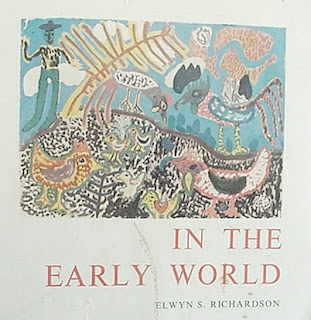
First published in 1964 this book, the result of eight years of teaching in a small isolated Northland school, has been republished by the nzcer. All creative teachers - or teachers who believe in personalizing learning should have a copy. Available from nzcer.
Recently I have been in communication with a post graduate student who is doing her thesis on the value of arts in education and, in particular, the work of pioneer New Zealand educator Elwyn Richardson.
As I a result I have re-read my copy and I am still stunned by the quality of the creative work that illustrates the book - I see little of such quality in schools I visit today. Maybe it is time to go back to see what was achieved a way back then and see what we can make use of today - even as an antidote to the soulless technocratic documents the Ministry of Education has sent out to schools the last decades
The following thoughts have been extracted from the insightful forward to Elwyn's book written by John Melser - well worth a read in itself.
'Education is the greatest adventure mankind has yet undertaken', John writes, 'and that so far it is only in the uncertain beginnings of what will be along evolution.' Elwyn's book he believes is a vital experiment in this evolution and is a 'vivid picture of of a school full of vitality in pursuit of values deeply rooted in the children's lives'. Elwyn's school, he writes, was a ' community of artists and scientists who turned their frank and searching gaze on all that came within their ambit. Curiosity and emotional force led them to explore together the natural world and the world of feelings.' The students learnt to , ' esteem each other's explorations, discoveries, and records...so that a fine collective strength was developed, a strength depending on each child making an individual search and bringing to the group what only he could give'.
Who wouldn't want this said about their school or class today?
Elwyn's students' studies, 'grew naturally out of what preceded them. New techniques were discovered and skills practiced as each achievement set new standards. In such an 'integrated' curriculum the integrity of persons is preserved even more that the integrity of topics.' 'From their paintings, their prints and their pottery they learnt answers to the question 'who am I''.
Elwyn's school functioned as, 'a community of artist scientists' .... 'because of the individualism of its members - each person counted and was expected to make his own contribution to its life. Personal views, even eccentric views, were welcomed', and there was an, 'affectionate acceptance' of the strengths and limitations of of each member of the group,'
One of the most important aspect of Elwyn's school was, 'to see how aesthetic standards were established and maintained.' In this process, Melser writes, the teacher's role is a delicate one, 'with the teacher leading and directing and at the same time humbly ready to learn from the students'. The learning community that grows out of this relationship between the teacher and the students allowed each new achievement to become a, 'springboard for later leaps in imagination and understanding'.
Children will grow, Melser states in his forward, 'in imaginative and aesthetic insight only in a classrooms where high standards prevail and where work will be tested by the critical insight of others, so both strengths and weaknesses are revealed.' At the beginning. Melser writes, such discrimination comes from the teachers but eventually the 'weight of feelings becomes a community one', if it remains with the teacher it will produce 'imitative performances' - a feature of many classrooms today overly influenced by imposed exemplars and criteria.
I loved Melser's description entering Elwyn's room to , 'be dazzled by a riot of colours, shapes, and textures. Drums , pots, mobiles dangling from the ceiling, masks, paintings, printing gear, a small electric kiln - all the disorder of a dozen simultaneous workshops was pent up in this small room.But there was a recognizable pattern, or perhaps a series of patterns, the kind of patterns children can feel at home in, where organisation is sometimes the minimum amount necessary for efficient working.' With the students present an absorption the students in their tasks was seen as the students, as artists and scientists, went about their work.
We could do worse in New Zealand tha to acquire a copy of this book and see what we can learn from Elwyn's teaching. As Melser writes, Elwyn gave , 'children the opportunity to reach their full heights as artists, as craftsman, as scientists, and as students, through the establishment of a community where self respect demanded this generosity of giving and receiving. In this sense every classroom can uniquely express its own mode of of co-operative individualism.'
Future generations of students need to be given similar respect.
Read the book to see what has been missing these past decades.
4 comments:
Great stuff but I bet few of todays teachers have ever heard of him.
It is wonderful it has been reprinted - there is nothing to match it anwhere in the world.
Have a great trip Bruce. You could blog and let us all know what you have seen and heard !
I ordered several copies of "In The Early World" today.
My question is "What would Richardson have done with 4 apple emacs in the classroom ?"
Elwyn had a collection of old printing presses that he used to publish his writings - if he had access to computers who knows what he might have done. My equally talented retired teacher friend Bill Guild is a whizz on his apple mac - makes most teachers use of them less than wonderful.
Post a Comment